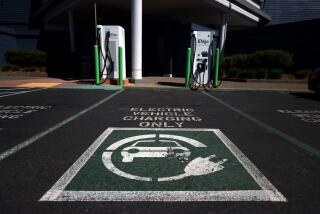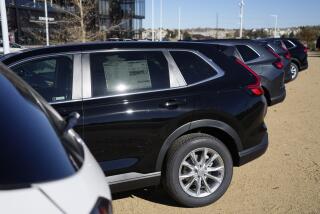Auto Industry Shifts Hybrids Into High Gear
SAN DIEGO — When automakers rolled out the first hybrid cars, drivers who wanted their spectacular fuel economy had to settle for weird shapes and a lack of luxury options.
Now it seems the high-mileage, low-frills trend in hybrid automaking may prove shorter than a Hummer’s trips between fill-ups. Newer hybrids are using the added boost from their gas-electric engines for more acceleration and power. But more mean may equal less green.
To attract drivers looking for large and luxurious vehicles, automakers such as Lexus and General Motors Corp. are building hybrids with the look and size of regular cars. The focus on performance sacrifices some of the efficiency that got hybrids noticed in the first place.
Environmentalists say automakers are squandering fuel-scrimping technology that reduces air pollution as well as the nation’s reliance on foreign oil.
“Consumers are enthralled by hybrids because they sip gas and don’t guzzle it, and they pollute less,” said Dan Becker, director of the Sierra Club’s global warming program. “So if you have a hybrid that guzzles and doesn’t pollute less, then what are you doing?”
Though sales of large SUVs have taken a hit, luxury and mid-size SUVs continue to do well.
American automakers are launching hybrid versions of those vehicles to remain competitive in the areas where they are most profitable, said Anthony Pratt, an analyst who covers hybrids for J.D. Power & Associates in Westlake Village. It’s cheaper to modify an existing model than to build a new one,, and SUVs have more room for adding hybrid components than sedans, he said.
Automakers say gas guzzlers also have the most room for improvement. But some hybrids barely get better mileage than their non-hybrid counterparts.
Take the hybrid Chevrolet Silverado, which gets the same 19 miles per gallon on the highway as a regular Silverado. On city streets it gets 17 mpg, 2 mpg more than the non-hybrid.
The Silverado is among six hybrids available from or being designed by GM, the world’s largest automaker. All but one are SUVs or trucks.
GM says small improvements make a big difference.
Upping an SUV’s performance from 10 mpg to 11 mpg will save 109 gallons of gasoline every 12,000 miles. That’s more than the 100 gallons saved over the same distance by lifting a sedan’s fuel economy from 30 to 40 mpg.
The reason for the greater fuel savings in an SUV is that the SUV uses so much more fuel than a sedan does. The 11-mpg SUV needs 1,091 gallons to go 12,000 miles; the 40-mpg sedan needs only 300 gallons.
An estimated 220,000 hybrids will be sold in the U.S. this year, about 1.3% of the market, according to J.D. Power. That’s a major jump from last year, when 87,000 hybrids accounted for 0.5% of car sales.
Some researchers believe consumers shouldn’t have to choose between performance and efficiency. At San Diego State, engineering professor Jim Burns led a student team that built the Enigma -- a diesel hybrid convertible that goes from zero to 60 mpg in 4.3 seconds while getting 80 mpg.
Burns, who says he would consider marketing Enigmas for $60,000 apiece if he could get 1,000 orders, says it will take flash, not just good mileage, to make the public fall in love with hybrids.
Some environmentalists are experimenting with the same pragmatic approach.
This year the Sierra Club handed out its first praise for a hybrid SUV, Ford’s Mercury Mariner, which gets an EPA-rated 33 mpg city and 29 mpg highway.
“I think it would be vastly preferable for everyone to drive a 45- or 55-mpg vehicle and the technology exists to do that,” said Becker, the organization’s global warming specialist. “But not everyone wants to buy a sedan.... If they’re going to buy an SUV, it’s better that they buy one that gets over 30 mpg than under 20.”






